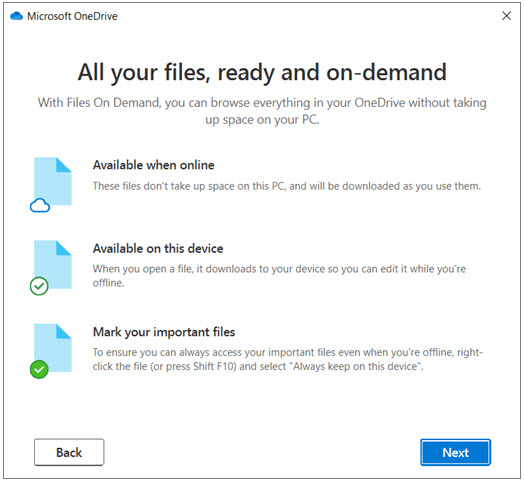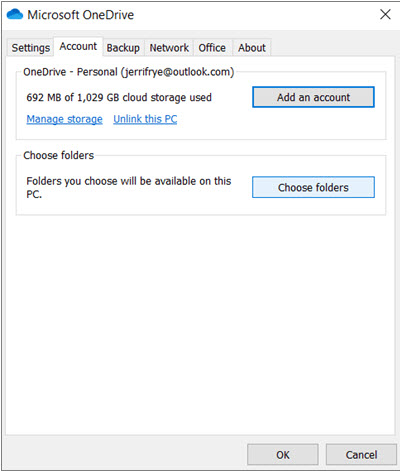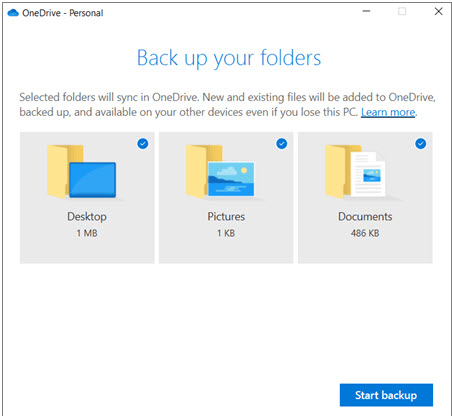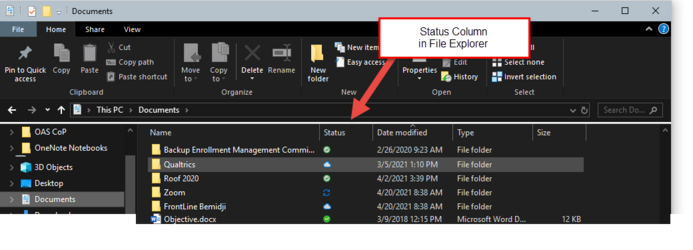OneDrive sync app
| REVISION IN PROGRESS: This article contains useful information, but is being revised to reflect recent updates. Direct questions to TLT (tlt@winona.edu). |
Use the OneDrive sync app to create copies of OneDrive files on your computer that automatically synchronize with the corresponding files in the cloud. This allows you to edit your OneDrive files when you are offline. When you reconnect, changes are synchronized with the cloud copies of the files such that your files are always up to date. You can sync all files or selected files and folders.
What does it mean to synchronize your OneDrive?
Your OneDrive exists in the cloud, and you need an Internet connection to access the folders and files it contains. Having a copy of those folders and files saved locally on your laptop's hard drive is allows you to access them even offline. However, it can be a file management nightmare if those two copies are not synchronized automatically. If you change the local copy of a document, that document should also be updated in your OneDrive. If you add a document to a local folder, a copy should also be placed in your OneDrive. If you make changes in your OneDrive, those changes should also be made to your local copy of those folders and files. The cloud and the local copy should always be the same. That's synchronization.
How does OneDrive synchronization work?
OneDrive synchronization works on both Windows and Mac operating systems. To set up synchronization, you have to download and install the OneDrive sync app. This may already be installed on your HP laptop. This creates a copy of your entire OneDrive folder and file structure in your home directory on your computer's hard drive. Any change you make to the files and folders in this local directory will automatically be copied to your OneDrive in the cloud. Conversely, any change you make to the folders and files in your OneDrive will be copied to your local directory automatically.
Setting up OneDrive Sync
- Select the Start button, search for "OneDrive", and then open the app.
- When OneDrive starts, enter your starid@minnstate.edu, and select Sign in.
- On the All your files, ready and on-demand screen, you'll see definitions for how files are marked to show them as online-only, locally available, or always available. Files On-Demand helps you access all your files in OneDrive without having to download all of them to your hard drive and use storage space, since you get 1TB of space in OneDrive and limited space on your hard drive. The files with the open blue cloud are not actually copied to your computer, just the name of the file is. Each file can be modified to "Always keep on this device" or free up space so only the name of the file shows. See Files On-Demand for more information on how this works.
- Select Next.
- To see which folders you are syncing or if you want to change which folders you want to sync, right-click the blue cloud icon in the taskbar notification area, and select Settings > Account > Choose folders.
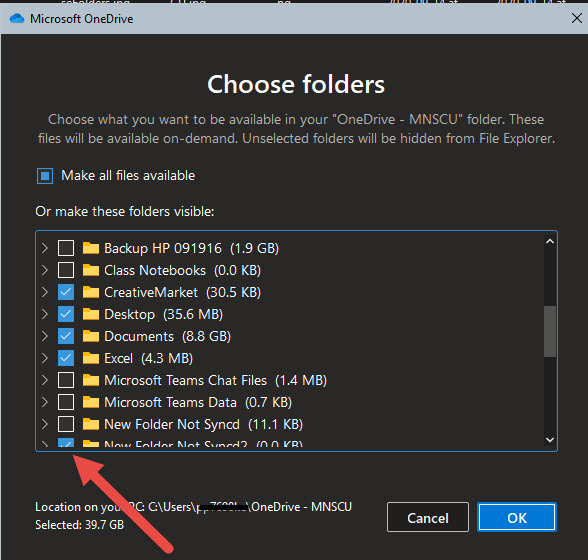 Simply un-check a box to deselect folders or documents that you no longer want synced to your computer. Files will remain in the cloud with OneDrive, but free up space on your computer.
Simply un-check a box to deselect folders or documents that you no longer want synced to your computer. Files will remain in the cloud with OneDrive, but free up space on your computer.
- Back up your folders dialog box allows you to choose which folders you want to back up or sync to OneDrive.
- Once OneDrive sync client has been set up, a blue cloud icon will show up in the system tray.
- File Explorer will now have a folder OneDrive - MNSCU that will have all the local files that sync with the cloud in it.
 File Explore can be used to move a file between a folder in your PC and a folder in OneDrive, or drag files where you want them.
File Explore can be used to move a file between a folder in your PC and a folder in OneDrive, or drag files where you want them.
In File Explorer you will also see a "Status column" to the right of the names of the files or folders. It is a good idea to make sure this column is there. If your sync stops for any reason, this column will disappear. The meaning of the different clouds is listed above on this page under Setting up OneDrive Sync. For more information about Files On-Demand.
Important: If you stop syncing a folder, all existing files will stay in OneDrive and your folder on your PC will be empty, but new files will save to your PC.
Fix problems with OneDrive Sync
Make sure that you see the blue cloud in your system tray at the bottom of your screen to know that OneDrive Sync is running:
If you do not see the blue cloud then you might need to Enable it to start at Startup: go to Task Manager > Startup > find Onedrive in the program list and click Enable.
If you see a symbol on top of the blue cloud, that means that the sync most likely has stopped and you need to take action to resolve an error. Right click on the blue cloud and you will be prompted on what steps to take.
Here are a list of errors you might see and how to resolve them:
- The file name isn't allowed in OneDrive: File names can't start with a space or include any of these characters: \ : / * ? < > " |. Please move or rename the file to continue.
- File exceeds the maximum path length: Make sure the entire file path, including the file name, contains fewer than 260 characters. An example of a file path is:
C:\Users\pp7698kl\OneDrive - MNSCU\OAS CoP\Teams\Training\Sync OneDrive for Business on Windows 10... To resolve this, shorten the name of your file or the name of the subfolders in OneDrive, or select a sub-folder that's closer to the top-level folder.
- File exceeds the maximum file size: OneDrive can't sync files over 250GB. Remove these files from the folder you want to protect and then try again.
- The following file type can't be protected: Outlook database files (.pst)
Additional Resources
Which OneDrive sync client am I using?
Sync SharePoint sites with the new OneDrive sync client
Transition from the existing OneDrive for Business sync client
